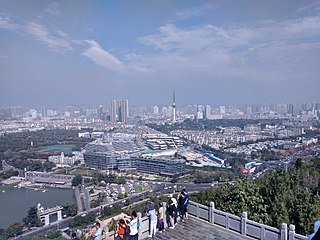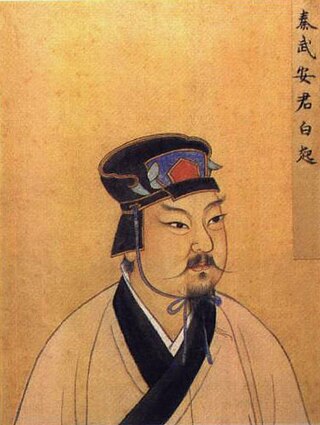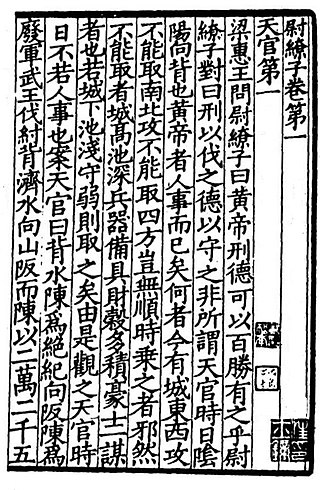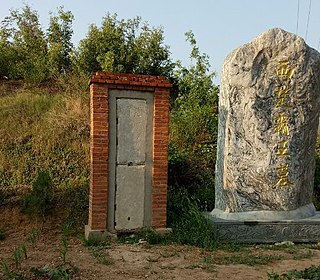Related Research Articles

The Yellow River is the second-longest river in China, after the Yangtze River, and the sixth-longest river system on Earth at the estimated length of 5,464 km (3,395 mi). Originating at an elevation above 15,000 feet in the Bayan Har Mountains, it empties into the Bohai Sea. The Yellow River's basin was the birthplace of ancient Chinese civilization.

Qin Shi Huang was the founder of the Qin dynasty and the first Emperor of China. Rather than maintain the title of "king" (王) borne by the previous Shang and Zhou rulers, he assumed the invented title of "emperor" (皇帝), which would see continuous use by monarchs in China for the next two millennia.

The Warring States period was an era in ancient Chinese history characterized by warfare, as well as bureaucratic and military reforms and consolidation. It followed the Spring and Autumn period and concluded with the Qin wars of conquest that saw the annexation of all other contender states, which ultimately led to the Qin state's victory in 221 BC as the first unified Chinese empire, under the Qin dynasty.

Huai'an, formerly Huaiyin, is a prefecture-level city in central Jiangsu Province in Eastern China. As of 2020, the built-up area (metro) of its 3 central urban districts had 2,544,767 inhabitants and the prefecture-level city as a whole had 4,556,230 inhabitants, down from 4.8 million in 2010.
The sexagenary cycle, also known as the stems-and-branches or ganzhi, is a cycle of sixty terms, each corresponding to one year, thus a total of sixty years for one cycle, historically used for recording time in China and the rest of the East Asian cultural sphere. It appears as a means of recording days in the first Chinese written texts, the Shang oracle bones of the late second millennium BC. Its use to record years began around the middle of the 3rd century BC. The cycle and its variations have been an important part of the traditional calendrical systems in Chinese-influenced Asian states and territories, particularly those of Japan, Korea, and Vietnam, with the old Chinese system still in use in Taiwan, and in Mainland China.

Xuzhou, also known as Pengcheng (彭城) in ancient times, is a major city in northwestern Jiangsu province, China. The city, with a recorded population of 9,083,790 at the 2020 census, is a national complex transport hub and an important gateway city in East China. Xuzhou is a central city of Huaihai Economic Zone and Xuzhou metropolitan area. Xuzhou is an important node city of the country's Belt and Road Initiative, and an international new energy base. Xuzhou has won titles such as the National City of Civility (全国文明城市) and the United Nations Habitat Scroll of Honour award.

Hanzhong is a prefecture-level city in the southwest of Shaanxi province, China, bordering the provinces of Sichuan to the south and Gansu to the west.
According to Sima Qian, Confucius said: "The disciples who received my instructions, and could themselves comprehend them, were seventy-seven individuals. They were all scholars of extraordinary ability." It was traditionally believed that Confucius had three thousand students, but that only 72 mastered what he taught. The following is a list of students who have been identified as Confucius's followers. Very little is known of most of Confucius's students, but some of them are mentioned in the Analects of Confucius. Many of their biographies are recorded in the Sima Qian's Shiji. The Six Arts were practiced by the 72 disciples.

Bai Qi, also known as Gongsun Qi (公孫起), was a Chinese military general of the Qin state during the Warring States period. Born in Mei, Bai Qi served as the commander of the Qin army for more than 30 years, being responsible for the deaths of over one million, earning him the nickname Ren Tu. According to the Shiji, he seized more than 73 cities from the other six hostile states, and to date no record has been found to show that he suffered a single defeat throughout his military career. He is regarded by Chinese folklore as one of the four Greatest Generals of the Late Warring States period, along with Li Mu, Wang Jian, and Lian Po; he is also remembered as the most fearsome amongst the four.

The burning of books and burying of scholars, also known as burning the books and executing the ru scholars, refers to the purported burning of texts in 213 BCE and live burial of 460 Confucian scholars in 212 BCE by the Chinese emperor Qin Shi Huang of the Qin dynasty. This was alleged to have destroyed philosophical treatises of the Hundred Schools of Thought, with the goal of strengthening the official Qin governing philosophy of Legalism.
The Si River is a river in Shandong Province, China. It also ran through the area of modern Jiangsu Province until floods in 1194.

The Wei Liaozi is a text on military strategy, one of the Seven Military Classics of ancient China. It was written during the Warring States period.
Jiandi Dao (湔氐道) was a prefecture of ancient China located around today's Songpan region, in the east of Qingzang Plateau and northwest part of Sichuan province.

Qin's wars of unification were a series of military campaigns launched in the late 3rd century BC by the state of Qin against the other six powers remaining in China — Han, Zhao, Yan, Wei, Chu and Qi. Between 247 and 221 BC, Qin had developed into one of the most powerful of China's Seven Warring States that coalesced in the wake of the Zhou dynasty's decline, by now retaining a weak and merely ceremonial position among the warring states. In 230 BC, King Ying Zheng of Qin began the sequence of campaigns that would bring the Warring States period to a close, setting out to conquer each remaining sovereign one by one. This was completed in 221 BC with the fall of Qi, leaving the former Zhou sphere unified under a more centralized Qin control. Ying Zheng declared himself the First Emperor, or Qin Shi Huang—becoming the first sovereign over a unified China under the imperial Qin dynasty,.

The Ordos Plateau, also known as the Ordos Basin or simply the Ordos, is a highland sedimentary basin in parts of most Northern China with an elevation of 1,000–1,600 m (3,300–5,200 ft), and consisting mostly of land enclosed by the Ordos Loop, a large northerly rectangular bend of the Yellow River. It is China's second largest sedimentary basin with a total area of 370,000 km2 (140,000 sq mi), and includes territories from five provinces, namely Shaanxi, Gansu, Ningxia, Inner Mongolia and a thin fringe of Shanxi, but is demographically dominated by the former three, hence is also called the Shaan-Gan-Ning Basin. The basin is bounded in the east by the Lüliang Mountains, north by the Yin Mountains, west by the Helan Mountains, and south by the Huanglong Mountains, Meridian Ridge and Liupan Mountains.
Cao Jun, courtesy name Zi'an, was a prince of the state of Cao Wei in the Three Kingdoms period of China. He was a son of Cao Cao, a warlord who rose to prominence towards the end of the Han dynasty and laid the foundation for the Cao Wei state. His mother was Lady Qin (秦夫人), a concubine of Cao Cao. She also bore Cao Cao another son, Cao Xuan. Cao Jun was enfeoffed as the Marquis of Mei (郿侯) in 216 during the reign of Emperor Xian in the Eastern Han dynasty. His marquisate was changed to Xiangyi County in the following year. In 221, a year after Cao Jun's elder half-brother Cao Pi ended the Han dynasty and established the state of Cao Wei, Cao Jun was promoted from a marquis to a duke. In 222, he received the title "Prince of Chenliu" (陳留王). Two years later, his princedom was changed from Chenliu to Xiangyi County. In 232, during the reign of Cao Pi's son Cao Rui, Cao Jun's princedom was relocated back to Chenliu. Cao Jun died in 259 during the reign of Cao Mao.

The Shudao, or the Road(s) to Shu, is a system of mountain roads linking the Chinese province of Shaanxi with Sichuan (Shu), built and maintained since the 4th century BC. Technical highlights were the gallery roads, consisting of wooden planks erected on wooden or stone beams slotted into holes cut into the sides of cliffs.
Zhang Cang 張蒼 was a Chinese military general, philosopher, and politician during the Western Han dynasty. He was the representative thinker of the Yin-Yang School, as well as a Confucian scholar, army general and prime-minister under Liu Bang. Evidence on his life is contained in the Book of Han and some other sources.

Jiuxian Township is a rural township in Dongping County, Shandong, China. It's surrounded by Hongfanchi Town on the east, Dong'e Town on the north, Dong'e County on the northwest, Banjiudian Town on the west, Dongping Lake on the southwest, and Laohu Town on the south. As of the 2017 census it had a population of 28,000 and an area of 73 square kilometres (28 sq mi).

Liang was a kingdom/principality in Han dynasty. Its territories was located within the modern Henan, Anhui and Shandong provinces.
References
- ↑ "Preface to "History of Natural Disasters in Xuzhou"". Collected Papers of History Studies. 1996-01-13. ISSN 0559-8095.
- ↑ "悲《瓠子》而作《河渠书》". Wenhui Bao. 2010-06-07. Archived from the original on 2012-04-25.
- ↑ See: (云龙山)
- ↑ http://sqtg.cnxz.com.cn/xzrb/html/2010-01/26/content_368409.htm%5B%5D